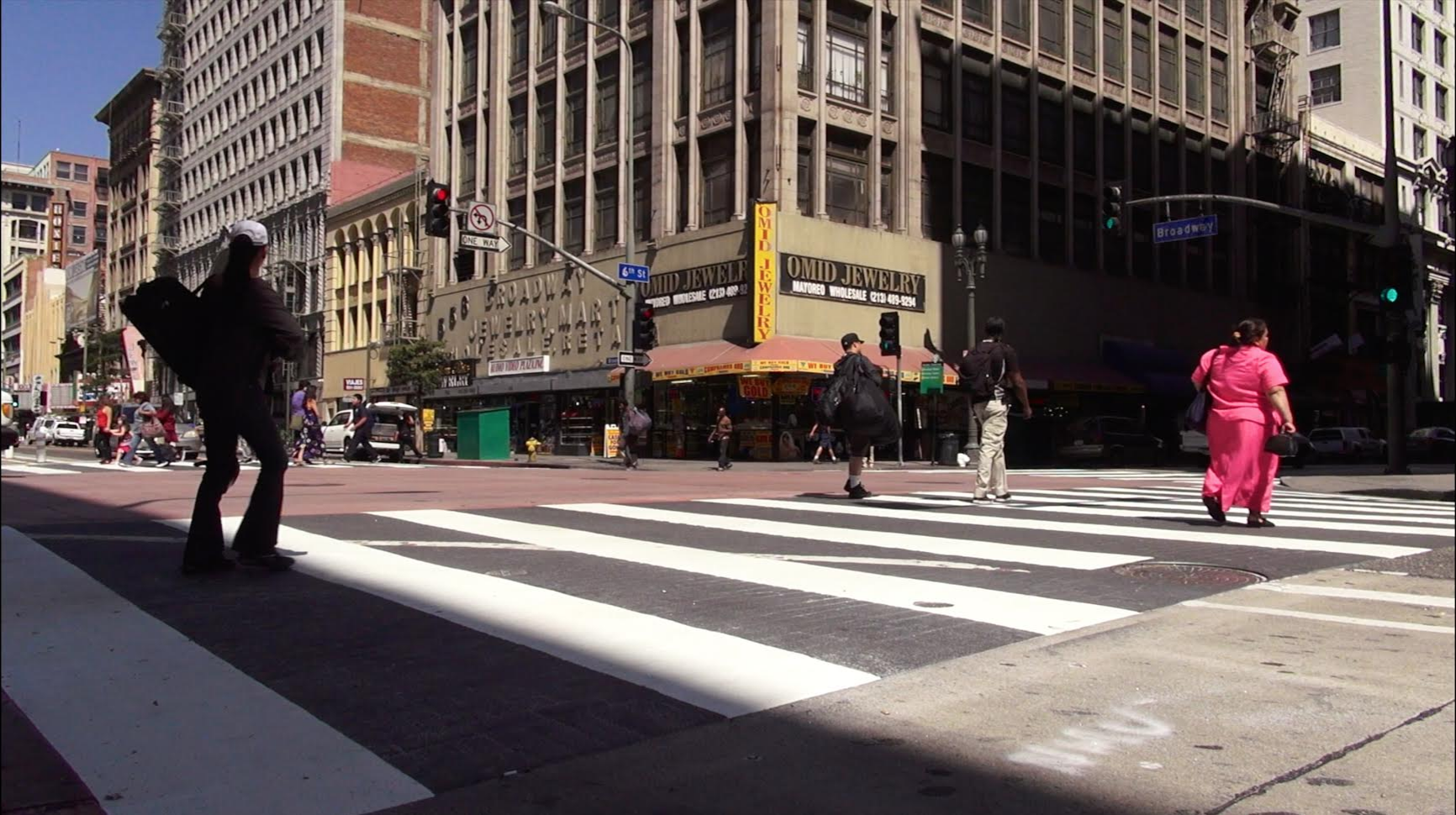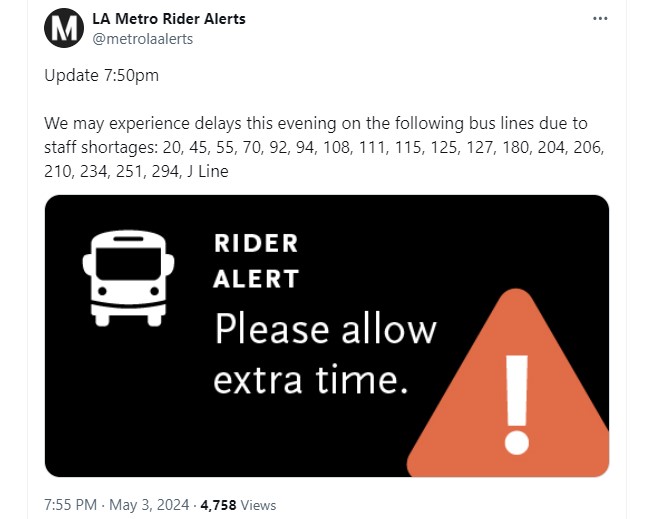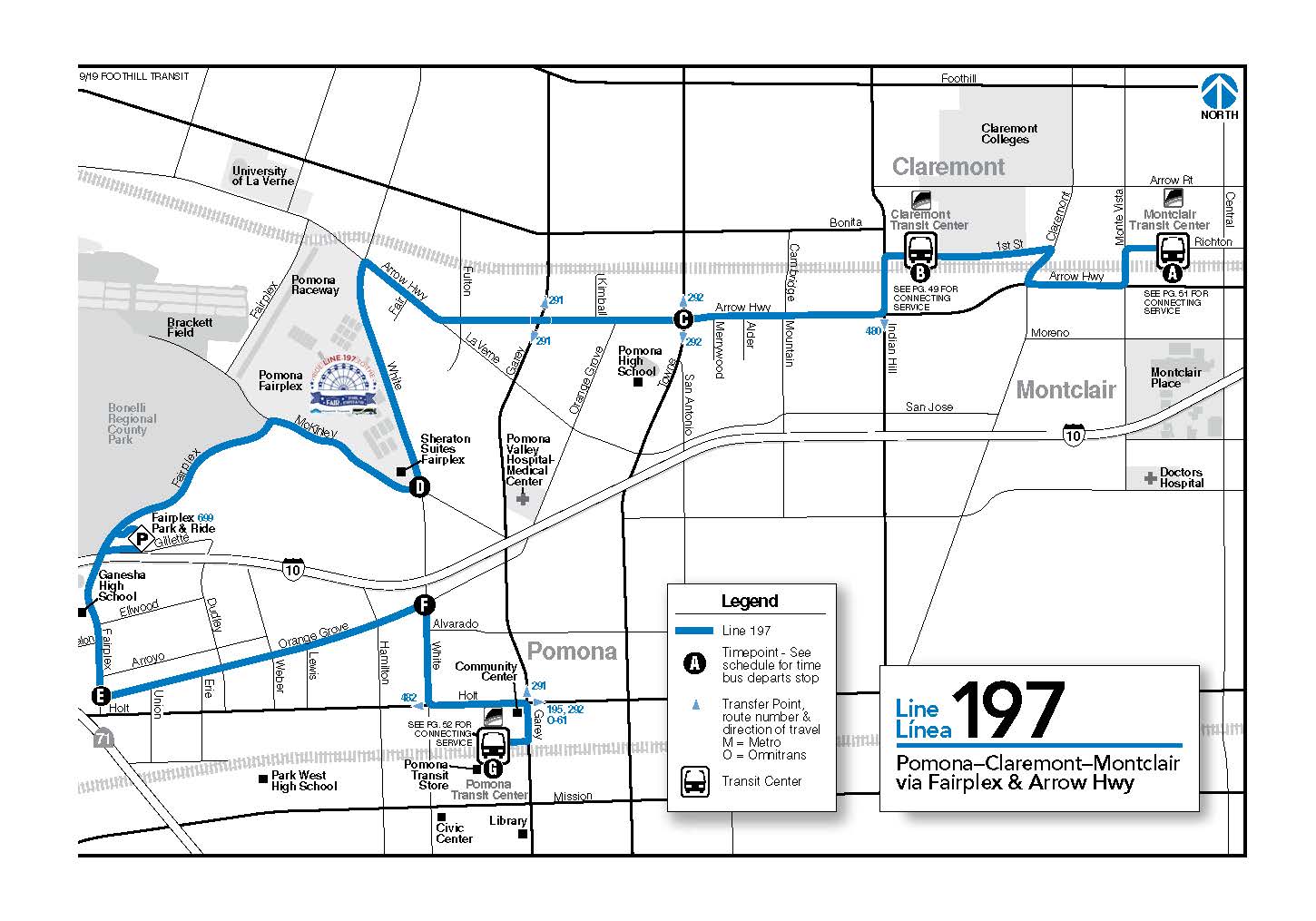Montclair Is Misguided In Penalizing Supposed “Distracted Walking”
2:20 PM PST on March 8, 2018

Does Montclair targeting pedestrians really make them safer? DTLA pedestrians photo via LADOT
The media has had a hard time approaching the application of “distracted walking” laws, or the supposed phenomenon of “distracted walking,” with anything close to a reasonable amount of rigor, objectivity, or skepticism.
An example is the Los Angeles Times’ February 25, 2018, article on the city of Montclair’s new “distracted walking” ordinance, which makes the use of a cellphone, or headphones, while crossing the street a ticketable offense. Right off the bat, the Times piece gets it wrong:
Chances are, you’ve had this experience: You’re behind the wheel at a stop sign or traffic light and have the right of way, when a pedestrian, looking down at a cellphone, steps off the curb in front of your car.
Chances aren’t that I and a lot of other people who do not or only rarely drive have had that experience. I don’t own a car, and I don’t typically step off a sidewalk into busy, fast-moving traffic like some clueless Mr. Magoo. Chances are that those of us who walk, bike, or ride transit have experienced drivers taking any advantage they can, legal or illegal, that allows them to drive faster and with fewer delays. But that’s another story I guess.
More to the point, the Montclair ordinance is at best a well-intentioned but misguided attempt at making safer streets - legislated by city leaders who suffer from extreme windshield bias. It’s also one more example of our car-centric society’s tendency to classify city streets as spaces solely for automobiles and place the responsibility for safety on anyone who is not driving.
The first question is whether “distracted walking,” as a determinant of collisions, warrants a new law and enforcement to back it up - or whether other behavior is more impactful. From January of 2012 to December of 2016, according to CHP SWITRS data, “Unsafe speed” (22 percent of collisions) was the most prevalent primary collision factor for collisions in Montclair. This makes sense; nationally, speeding is one of the most common factors in motor vehicle crashes, according to the federal National Transportation Safety Board. For collisions in Montclair involving a pedestrian, a violation of code section 21950 (failure by a driver to yield to pedestrian right of way in a crosswalk) was the number one factor, constituting 34 percent of all crashes.
Phone or no phone, speeding and moving violations seem to be an issue in the city of Montclair.
There’s no consideration in the Times article, or the law itself, of how current distracted driver laws (which operate under the problematic assumption that the hands-free use of electronics by motorists is okay) actually perform in terms of decreasing distracted driving and increasing safety. The city of Montclair’s website blithely states, “Distracted drivers differ from distracted pedestrians in the fact that distracted driving has policies and interventions in place to improve safety,” without any discussion of whether those policies and interventions have actually done anything to decrease distracted driving and improve safety for all.
This new law also warrants the question, seemingly unasked: how would enforcement be equitable? Besides issues of equity between enforcement of driving violations (where the vehicle can kill) and walking violations (where the human body cannot) as well as the inherent issues of racial profiling that come with any enforcement action, there are issues concerning class and geography that should give us pause. Over two years ago Steve Lopez wrote in the L.A. Times about inequity in downtown L.A. pedestrian ticketing. Last week, Sahra Sulaiman of Streetsblog L.A. highlighted the needless prolonged detention and harassment of an East L.A. jogger. Given our understanding of what the most common factors in Montclair’s crashes are, it raises the question of why pedestrian enforcement, and the problems that come with it, seems to be how the city government wants to make streets safer.
Think also of the reality a law like Montclair’s envisions: while driving you are not supposed to hold your phone in your hands, but you can still place it on your dashboard and interact with it. Your car might have a touchscreen, possibly with web browsing options. You can have your music cranked up to 11 with the windows up while driving. But outside the car, while walking across the street, you can’t use the phone at all. Jogging with headphones, something people have done since the Walkman, is now criminalized.
The privileges are for inside the car, not outside, and the responsibility for ensuring safety for people walking is placed outside the car, not inside.
The sad fact is that, by and large, we already accept that sure, there are bad drivers here and there, but by and large traffic is just a natural, unstoppable, flowing force. It follows that the only thing people walking and biking can do is get out of the way.
This windshield bias is what causes people to react skeptically to solutions that make streets safer for all road users, including people who walk, bike, and drive, children, seniors and people with disabilities – in other words: everyone. Windshield bias is also what leads to calls for “personal responsibility” by people walking. But much like in national politics, the punitive measures enforcing personal responsibility tend to apply harshly to the most vulnerable people, while the larger factors affecting those without power go unaddressed.
Rather than tackle the major determinants of our traffic violence (and the rate of traffic fatalities in the United States far exceeds that of other developed nations), Montclair is now spending its time and money developing laws that it insists will increase safety for its most vulnerable road users by penalizing them.
Montclair will ticket 15-year-olds crossing the street with ear buds but won’t ask why a Toyota Celica should be able to go 100 mph.
It’s absurd. Should we try to reduce our gun deaths by giving everyone a Kevlar vest and ticketing those that don’t use a mirror to check around corners? Or should we try and just reduce the amount of damn guns we have?
So what should Montclair be doing?
It should look to the examples of progress made in cities like New York and San Francisco, which have adopted Vision Zero plans aimed at completely eliminating traffic fatalities. Both cities had the lowest number of traffic fatalities last year since they began keeping records more than a century ago. In both cases, they’ve attacked speed and unsafe driving, which are by far the two biggest causes of traffic deaths.
If someone is hit by a car traveling 20 mph, he or she has a 10 percent risk of death. At 40 mph, the risk increases to 80 percent. Lowering speed limits, making road design changes to reduce speeding, making design and signal changes to intersections, and providing more physical space and protection for people walking are all proven ways for Montclair to boost pedestrian safety. They all beat targeting people walking who pose no significant risk to any other road users.
Mehmet Berker is a cartographer and GIS specialist living in Los Angeles.
Read More:
Stay in touch
Sign up for our free newsletter
More from Streetsblog Los Angeles
This Week In Livable Streets
Bike Month continues, Metro 91 Freeway widening, Destination Crenshaw, Culver City Bus, Santa Monica MANGo, Metro bike lockers, Metro Sepulveda Transit, and more
San Fernando Valley Bus/Bike Updates: G Line, Roscoe Bus Lanes, Laurel Canyon Bike Lanes
Short newly protected bike lane on Laurel Canyon Blvd, extensive NSFV bus improvements under construction this month, and scaled-back G Line plans should get that project under construction this summer
No, L.A. City Does Not Always Add Required ADA Ramps During Resurfacing, But They Should
StreetsLA GM Keith Mozee "Any time we do street resurfacing, it is considered an alteration, which requires ADA ramps to be installed."




